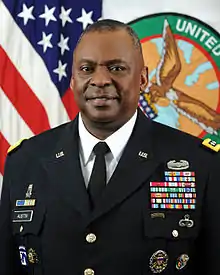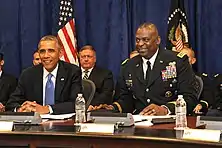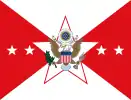Lloyd Austin
Lloyd James Austin III (born August 8, 1953) is a retired United States Army four-star general who has been the United States secretary of defense since January 22, 2021. He is the first African American to serve as U.S. Defense Secretary. Austin previously served as the 12th commander of United States Central Command (CENTCOM) from 2013 to 2016.
Lloyd Austin | |
|---|---|
.jpg.webp) | |
| 28th United States Secretary of Defense | |
| Assumed office January 22, 2021 | |
| President | Joe Biden |
| Deputy | David Norquist Kathleen Hicks (nominee) |
| Preceded by | Mark Esper |
| 12th Commander of United States Central Command | |
| In office March 22, 2013 – March 30, 2016 | |
| President | Barack Obama |
| Preceded by | Jim Mattis |
| Succeeded by | Joseph Votel |
| 33rd Vice Chief of Staff of the United States Army | |
| In office January 31, 2012 – March 8, 2013 | |
| President | Barack Obama |
| Preceded by | Peter W. Chiarelli |
| Succeeded by | John F. Campbell |
| Personal details | |
| Born | Lloyd James Austin III August 8, 1953 Mobile, Alabama, U.S. |
| Spouse(s) | Charlene Banner |
| Education | United States Military Academy (BS) Auburn University (MA) Webster University (MBA) |
| Signature |  |
| Military service | |
| Allegiance | |
| Branch/service | |
| Years of service | 1975–2016 |
| Rank | |
| Commands | |
| Battles/wars | War in Afghanistan Iraq War |
Austin was the 33rd vice chief of staff of the Army from January 2012 to March 2013, and the last commanding general of United States Forces – Iraq Operation New Dawn, which ended in December 2011. In 2013, Austin was the appointed as the first black commander of CENTCOM by President Barack Obama.[1] He retired from the armed services in 2016 and joined the boards of Raytheon Technologies, Nucor, and Tenet Healthcare.
Early life and education
Austin was born on August 8, 1953, in Mobile, Alabama[2] and raised in Thomasville, Georgia.[3] He graduated from the United States Military Academy (West Point) with a Bachelor of Science degree in 1975, where he was commander of G-1 (G Company, 1st Regiment).[4][5] He later earned a Master of Arts degree in counselor education from Auburn University's College of Education in 1986, and a Master of Business Administration in business management from Webster University in 1989. He is a graduate of the Infantry Officer Basic and Advanced courses, the Army Command and General Staff College, and the Army War College.[5]
Military career

Austin was commissioned as a second lieutenant after graduation from West Point.[5] His initial assignment was to the 3rd Infantry Division (Mechanized) in Germany.[5]
Following this assignment and attendance at the Infantry Officer Advanced Course, he was assigned to the 82nd Airborne Division at Fort Bragg, North Carolina, where he commanded the Combat Support Company, 2nd Battalion (Airborne), 508th Infantry and served as the Assistant S-3 (Operations) for 1st Brigade, 82nd Airborne Division.[5]
%252C_accepts_the_command_colors_from_U.S._Marine_Corps_Gen._Gen._James_N._Mattis%252C_the_commander_of_U.S._Central_Command_100901-N-TT977-288.jpg.webp)
In 1981, Austin was assigned to Indianapolis, Indiana, where he was the operations officer for the Army Indianapolis District Recruiting Command and later commanded a company in the Army Recruiting Battalion.[5] Upon completing this assignment, he attended Auburn University, where he completed studies for a master's degree in education. He was then assigned to the Military Academy at West Point, New York, where he served as a company tactical officer for E-1.[5]
After his selection and subsequent completion of the Army Command and General Staff College, Fort Leavenworth, Kansas, he was assigned to the 10th Mountain Division (Light Infantry), Fort Drum, New York, where he served as the S-3 (Operations) and later executive officer for the 2nd Battalion, 22nd Infantry. He subsequently served as Executive Officer for 1st Brigade, 10th Mountain Division (Light Infantry) and later as Director of Plans, Training, Mobilization and Security for Fort Drum, New York.[5]
In 1993, Austin returned to the 82nd Airborne Division at Fort Bragg, North Carolina where he commanded the 2d Battalion (Airborne), 505th Infantry.[6] He later served as the G-3 for the 82nd Airborne Division. Following graduation from the Army War College, he commanded the 3rd Brigade, 82nd Airborne Division at Fort Bragg, North Carolina.[5]
Shortly after brigade command, he was assigned to The Pentagon in Arlington, Virginia, where he served as Chief, Joint Operations Division, J-3, on the Joint Staff. His next assignment was as Assistant Division Commander for Maneuver (ADC-M), 3rd Infantry Division (Mechanized), Fort Stewart, Georgia. As the ADC-M, he helped lead the division's invasion of Iraq in March 2003.[5] Austin was awarded a Silver Star for his actions as commander during the invasion.[7]
Austin served from September 2003 until August 2005 as the commanding general of the 10th Mountain Division (Light Infantry), with duty as Commander, Combined Joint Task Force 180, during the War in Afghanistan. His next position was chief of staff of the United States Central Command at MacDill AFB, in Tampa, Florida, from September 2005 until October 2006.[5]
On December 8, 2006, Austin was promoted to lieutenant general, and assumed command of the XVIII Airborne Corps, Fort Bragg, North Carolina.[8] In February 2008, Austin became the second highest ranking commander in Iraq, taking command of the Multi-National Corps – Iraq (MNC-I). As commander of MNC-I, he directed the operations of approximately 152,000 joint and coalition forces in all sectors of Iraq.[9]
Austin handed over command of XVIII Corps to become Director of the Joint Staff in August 2009.[5] This promotion came at the direction of Admiral Michael Mullen, Chairman of the Joint Chiefs of Staff at the time. While Director, Austin was told by Mullen to increase the diversity of the Joint Staff. Austin credited the appointment as having jumpstarted his later career, saying: "People who might not have known Lloyd Austin began to know him."[3]
Commanding General of US Forces – Iraq
.jpg.webp)
On September 1, 2010, Austin became Commanding General (CG) of United States Forces – Iraq (USF-I) at a ceremony at Al-Faw Palace in Baghdad. He took over from General Ray Odierno.[10][11] As CG, USF-I, Austin was the senior military commander in charge of all US and remaining coalition forces in Iraq.[12] Their mission was to advise, train, assist, and equip the Iraqi Armed Forces and the security agencies part of the Ministry of the Interior. As commander, Austin requested an additional troop presence in Iraq from 14,000 to 18,000.[13]
Austin oversaw the transition from Operation Iraqi Freedom and combat operations to Operation New Dawn and stability operations focused on advising, assisting, and training the ISF.[14] He was extensively involved in the internal U.S. discussions and then negotiations with the Iraqi Government leading up to the signing of the Strategic Partnership Agreement.[15] Opposing total U.S. withdrawal, Austin preferred that the U.S. maintain over about 10,000 troops in Iraq after 2011 and he approved staff planning for up to 20,000 remaining troops.[16][17] He directed the drawdown of forces and the redeployment of approximately 50,000 servicemembers. The U.S. command in Iraq formally cased its colors on December 15, 2011, at a reduced-sized BIAP complex, and Austin's speech there cited his division's seizure of the airport over eight years beforehand.[18] Austin, along with other members of the USF-I staff, departed Iraq on December 18, 2011.[19]
Army Vice Chief of Staff
In December 2011, Austin was nominated to become Vice Chief of Staff of the United States Army (VCSA).[20] He took office on January 31, 2012.[21] As VCSA, he managed the day-to-day administration of the Army's budget and headquarters staff. Under his direction, the Army took steps to reduce the incidence of suicide in the ranks.[22][23] He also supervised a review of the psychiatric treatment of personnel assessed for disability by the Army.[24]
United States Central Command

Austin became the commander of CENTCOM on March 22, 2013, after being nominated by President Obama in late 2012.[25][26][27] His approach as CENTCOM commander has been described as that of an "invisible general", due to his reluctance to speak publicly about military matters.[28]
As commander, after ISIL seized control of Mosul in June 2014, Austin oversaw the development and execution of the military campaign plan to counter ISIL in Iraq and Syria.[29][30] He had earlier described ISIL as a "flash in the pan".[31] As of October 2014, Austin argued that the US military's primary focus in operations against ISIL should be Iraq, as opposed to Syria.[32] In 2015, Austin conceded in a Senate Committee on Armed Services hearing that a US program intended to train Syrians to combat ISIL had not been successful.[33][34] At the hearing, he faced particularly pointed questioning from Senator John McCain over the direction of military engagement in Syria.[35]
Austin's retirement ceremony took place at Joint Base Myer–Henderson Hall on April 5, 2016.[36]
Austin was the second former CENTCOM Commander after General James Mattis who later on would serve as United States Secretary of Defense. Both Austin and Mattis was once CENTCOM Commander, Mattis was succeeded by Austin following Mattis retirement as CENTCOM Commander in 2013 and served as the 26th U.S. Secretary of Defense.[37]
Awards and decorations

| Defense Distinguished Service Medal with three oak leaf clusters [38] | |
| Distinguished Service Medal with two oak leaf clusters [38] | |
| Silver Star [38] | |
| Defense Superior Service Medal with oak leaf cluster [38] | |
| Legion of Merit with oak leaf cluster [38] | |
| Defense Meritorious Service Medal [38] | |
| Meritorious Service Medal with four oak leaf clusters [38] | |
| Joint Service Commendation Medal [38] | |
| Army Commendation Medal with five oak leaf clusters [38] | |
| Army Achievement Medal with oak leaf cluster [38] | |
| Army Presidential Unit Citation [38] | |
| Joint Meritorious Unit Award [38] | |
| Secretary's Distinguished Service Award, Department of State [38] | |
| National Defense Service Medal with two Service Stars [38] | |
| Armed Forces Expeditionary Medal [38] | |
| Afghanistan Campaign Medal [38] | |
| Iraq Campaign Medal [38] | |
| Global War on Terrorism Expeditionary Medal [38] | |
| Global War on Terrorism Service Medal [38] | |
| Humanitarian Service Medal [38] | |
| Army Service Ribbon [38] | |
| Army Overseas Service Ribbon [38] |
Private sector
Austin joined the board of Raytheon Technologies, a military contractor, in April 2016.[39][40] As of October 2020, his Raytheon stock holdings were worth roughly $500,000 and his compensation, including stock, totaled $1.4 million.[39] On September 18, 2017, he was appointed to Nucor's board of directors.[41] On May 29, 2018, Austin was appointed as an independent director on the board of Tenet Healthcare.[42] He also operates a consulting firm and has been a partner at Pine Island Capital, an investment company with which Antony Blinken and Michèle Flournoy are affiliated.[43][39]
Secretary of Defense
Nomination and confirmation
.jpg.webp)
On December 7, 2020, it was reported that President Joe Biden would nominate Austin as secretary of defense.[43][44] Biden became acquainted with Austin while Austin was CENTCOM commander in the Obama administration, and reportedly grew to trust Austin after receiving Austin's briefings.[45] Like former defense secretary James Mattis,[46] Austin required a congressional waiver of the National Security Act of 1947 to bypass the seven-year waiting period after leaving active-duty military, as prescribed by 10 U.S.C. § 113(a), in order to be appointed as secretary of defense.[45]
_A.jpg.webp)
.jpg.webp)
Austin's nomination, and the attendant requirement for a waiver, met with concern in Congress regarding its implications for civil–military relations.[47][48] Former Secretary of Defense Robert Gates and former Secretary of State Colin Powell, among others, issued statements supporting Austin's nomination.[49] Democratic Representative Seth Moulton opposed it.[50]
The Senate Armed Services Committee held a confirmation hearing for Austin on January 19, 2021.[51] On January 21, Congress granted Austin a waiver of the seven-year requirement, by a 326–78 vote in the House and a 69–27 vote in the Senate.[52][53] He was confirmed by the Senate in a 93–2 vote on January 22, 2021.[54] Republican Senators Josh Hawley and Mike Lee were the only no votes. Upon his confirmation and swearing-in later that day, Austin became the first Black secretary of defense.[55] Austin took office on January 22, 2021, after being sworn in by a defense department official, and was sworn in ceremonially by Vice President Kamala Harris on January 25, 2021.[56]
Actions
Among his early acts as Secretary of Defense, Austin removed Trump appointees from the Pentagon advisory boards.[57] As part of a review, he ordered for their resignations, most notably former House Speaker Newt Gingrich and former Trump campaign manager Corey Lewandowski. Many of the them were last minute appointees after the 2020 election up to Inauguration Day.
Personal life
Raised by a devout Catholic mother, Austin still practices the faith.[58][59] He has been described as an "intensely private" man[60] who loathed talking to the news media when he was in Iraq and has a habit of "referring to himself in the third person".[3]
Austin and his wife, Charlene Denise Banner Austin, have been married for over 40 years.[2][61] Charlene has worked as a non-profit administrator and served the board of the Military Family Research Institute at Purdue University.[62] He has two stepsons.[2][63]
Publications
- Austin, Lloyd J.; Pollack, Kenneth M.; Wittes, Tamara Cofman (August 14, 2015). The Middle East in Transition (Report). Washington, DC: Brookings Institution.
- Austin, Lloyd J. (September 16, 2015). Statement of General Lloyd J. Austin III, Commander, U.S. Central Command, Before the Senate Armed Services Committee on Operation Inherent Resolve (PDF) (Speech).
References
- MacAskill, Ewen (March 22, 2013). "General Lloyd Austin picked for top job at US Central Command". The Guardian. Archived from the original on February 9, 2017. Retrieved December 2, 2020.
- Nominations before the Senate Armed Services Committee, 2nd Session, 111th Congress (PDF) (Report). 2010. p. 327. S Hrg 111-896. Archived (PDF) from the original on September 26, 2020. Retrieved December 2, 2020.
- Cooper, Helene (December 9, 2020). "'Is Austin on Your List?': Biden's Pentagon Pick Rose Despite Barriers to Diversity". The New York Times. ISSN 0362-4331. Archived from the original on December 10, 2020. Retrieved December 10, 2020.
- "'Perfect People': Living the West Point Ideal". West Point Center for Oral History. Archived from the original on October 27, 2020. Retrieved December 8, 2020.
- "General Lloyd J. Austin III". United States Department of Defense. Archived from the original on September 5, 2015. Retrieved December 1, 2020.
 This article incorporates public domain material from websites or documents of the United States Department of Defense.
This article incorporates public domain material from websites or documents of the United States Department of Defense. - Brooks, Drew (April 10, 2016). "Gen. Lloyd Austin Ends 41-year Army Career". The Fayetteville Observer. Archived from the original on December 9, 2020. Retrieved December 11, 2020 – via Military.com.
- Dickstein, Corey (December 8, 2020). "Biden officially announces he's picked retired CENTCOM Gen. Lloyd Austin for defense secretary". Stars and Stripes. Archived from the original on December 9, 2020. Retrieved December 10, 2020.
- "Maj. Gen. Lloyd J. Austin III to Command Fort Bragg 18th Airborne Corps". Jet. Johnson Publishing Company. August 28, 2006. pp. 36–37. Archived from the original on December 11, 2020. Retrieved December 10, 2020.
- "DoD News Briefing with Lt. Gen. Austin III from Iraq". United States Department of Defense. June 23, 2008. Archived from the original (News Transcript) on January 12, 2009. Retrieved December 2, 2020.
 This article incorporates public domain material from websites or documents of the United States Department of Defense.
This article incorporates public domain material from websites or documents of the United States Department of Defense. - Dey, Roger M. (September 4, 2010). "Austin leads USF-I into New Dawn". United States Army. Archived from the original on January 26, 2019. Retrieved May 18, 2016.
- Gordon & Trainor 2013, p. 637.
- "USF-Iraq Commanding General". United States Forces – Iraq. December 5, 2010. Archived from the original on October 20, 2020. Retrieved December 2, 2020.
- Singh, Robert (2012). Barack Obama's Post-American Foreign Policy: The Limits of Engagement. Bloomsbury Publishing. p. 106. ISBN 978-1-78093-113-5. Archived from the original on December 8, 2020. Retrieved December 8, 2020.
- "Advance questions for General Lloyd J. Austin III" (PDF). United States Senate Committee on Armed Services. Archived (PDF) from the original on December 27, 2016. Retrieved December 2, 2020.
- Gordon & Trainor 2013, pp. 653–657.
- "Joe Biden picks Lloyd Austin as defense secretary". Deutsche Welle. Archived from the original on December 9, 2020. Retrieved December 9, 2020.
[Austin] subsequently oversaw the withdrawal of US troops in 2011, a decision which he disagreed with.
- Gordon & Trainor 2013, pp. 659–660, 662.
- Gordon & Trainor 2013, p. 671.
- Logan, Joseph (December 18, 2011). "Last U.S. troops leave Iraq, ending war". Reuters. Archived from the original on May 25, 2017. Retrieved May 19, 2016.
- "General Officer Announcements". United States Department of Defense. September 30, 2011. Release No 841-11. Archived from the original on October 26, 2012. Retrieved December 18, 2011.
 This article incorporates public domain material from websites or documents of the United States Department of Defense.
This article incorporates public domain material from websites or documents of the United States Department of Defense. - Dock-Abuhl, Courtney (March 12, 2013). "Austin sworn in as vice chief of staff". United States Army. Archived from the original on August 8, 2020. Retrieved December 1, 2020.
- "General Foresees Turnaround in Army Suicide Rate". CBS News. Associated Press. March 7, 2013. Archived from the original on October 28, 2018.
- "NFL Commissioner Roger Goodell, Army Vice Chief of Staff General Lloyd Austin, Reps. Mike Thompson, Gus Bilirakis Join Forces to Tackle Traumatic Brain Injury". Mike Thompson. September 12, 2012. Archived from the original on June 11, 2016. Retrieved May 19, 2016.
- Dao, James (May 17, 2012). "Army to Review Its Handling of Psychiatric Evaluations". The New York Times. ISSN 0362-4331. Archived from the original on November 11, 2020. Retrieved December 8, 2020.
- "General Lloyd J. Austin III Retires". Black Engineer.com. April 11, 2016. Archived from the original on June 4, 2016. Retrieved May 19, 2016.
- "Secretary Panetta Statement on Intent to Nominate CENTCOM Commander". United States Department of Defense. No 951-12. Archived from the original on April 15, 2013. Retrieved February 13, 2013.
 This article incorporates public domain material from websites or documents of the United States Department of Defense.
This article incorporates public domain material from websites or documents of the United States Department of Defense. - "Looking back for the way ahead: An interview with Retired Gen. Lloyd Austin". Office of the Deputy Chief of Staff. January 2, 2018. Archived from the original on December 8, 2020. Retrieved December 9, 2020.
- Ward, Alex (December 7, 2020). "Retired Gen. Lloyd Austin chosen as the first Black person to lead the Pentagon". Vox. Archived from the original on December 8, 2020. Retrieved December 8, 2020.
- Austin, Lloyd J. (September 16, 2015). "Statement of General Lloyd J. Austin III" (PDF). United States Senate Committee on Armed Services. Archived (PDF) from the original on February 25, 2016. Retrieved December 2, 2020.
- "Combined Forces Air Component Commander Airpower Statistics (as of 31 March 2016)" (PDF). Archived from the original (PDF) on August 19, 2016. Retrieved December 2, 2020.
- Goldberg, Jeffrey (April 2016). "The Obama Doctrine". The Atlantic. ISSN 1072-7825. Archived from the original on September 18, 2018. Retrieved December 9, 2020.
- Ackerman, Spencer (October 17, 2014). "US stresses Iraq emphasis even as air strikes escalate against Isis in Syria". The Guardian. ISSN 0261-3077. Archived from the original on November 11, 2020. Retrieved December 8, 2020.
- Cooper, Helene (September 16, 2015). "Few U.S.-Trained Syrians Still Fight ISIS, Senators Are Told". The New York Times. ISSN 0362-4331. Archived from the original on November 28, 2020. Retrieved December 8, 2020.
- Ackerman, Spencer (September 16, 2015). "US has trained only 'four or five' Syrian fighters against Isis, top general testifies". The Guardian. ISSN 0261-3077. Archived from the original on November 23, 2020. Retrieved December 8, 2020.
- Bender, Bryan; Seligman, Lara (December 8, 2020). "Questions swirl over Austin's limited experience". Politico. Archived from the original on December 9, 2020. Retrieved December 9, 2020.
- Callahan, Guv (April 8, 2016). "A Soldier's Soldier". United States Army. Archived from the original on May 7, 2016. Retrieved May 19, 2016.
- Rej, Abhijnan (January 23, 2021). "US Senate Confirms Lloyd Austin as Secretary of Defense". thediplomat.com. Retrieved January 27, 2021.
- Austin, Lloyd James. "Lloyd James Austin Awards by Date of Action". Hall of Valor Project. Archived from the original on January 15, 2021. Retrieved January 23, 2021.
- Lipton, Eric; Vogel, Kenneth P.; LaForgia, Michael (December 9, 2020). "Biden's Choice for Pentagon Faces Questions on Ties to Contractors". The New York Times. ISSN 0362-4331. Archived from the original on December 10, 2020. Retrieved December 11, 2020.
- "Lloyd J Austin III". Raytheon Technologies. Archived from the original on November 29, 2020. Retrieved November 28, 2020.
- "Nucor Announces the Addition of General Lloyd J. Austin III to the Nucor Board of Directors". PR Newswire. Archived from the original on September 14, 2017. Retrieved December 2, 2020.
- "Tenet Board Appoints Two Independent Directors". May 29, 2018. Archived from the original on May 30, 2018. Retrieved May 29, 2018.
- Seligman, Lara; Pager, Tyler; O'Brien, Connor; Bertrand, Natasha (December 7, 2020). "Biden picks retired general Lloyd Austin to run Pentagon". Politico. Archived from the original on December 7, 2020. Retrieved December 8, 2020.
- Cooper, Helene; Martin, Jonathan; Schmitt, Eric (December 8, 2020). "Biden Plans to Tap Lloyd Austin, Former Iraq Commander, as Defense Secretary". The New York Times. ISSN 0362-4331. Archived from the original on December 8, 2020. Retrieved December 8, 2020.
- Ordoñez, Franco; Johnson, Carrie; Wise, Alana (December 7, 2020). "Biden Expected To Nominate Gen. Lloyd Austin As Defense Secretary". NPR. Archived from the original on December 8, 2020. Retrieved December 8, 2020.
- Lamothe, Dan (December 1, 2016). "Trump picks retired Marine Gen. James Mattis for secretary of defense". Washington Post. ISSN 0190-8286. Archived from the original on December 1, 2016. Retrieved December 8, 2020.
- Steinhauer, Jennifer; Schmitt, Eric; Broadwater, Luke (December 8, 2020). "Biden's Pentagon Pick Reignites Debate Over Civilian Control of Military". The New York Times. ISSN 0362-4331. Archived from the original on December 9, 2020. Retrieved December 9, 2020.
- Desiderio, Andrew; O'Brien, Connor (December 8, 2020). "Democrats signal early opposition to Biden's Defense pick". Politico. Archived from the original on December 9, 2020. Retrieved December 9, 2020.
- Crowley, Michael; Schmitt, Eric (December 10, 2020). "Biden Asks Congress to Grant Waiver for 'Cool Under Fire' Defense Pick". The New York Times. ISSN 0362-4331. Archived from the original on December 10, 2020. Retrieved December 10, 2020.
- Seligman, Lara; Bender, Bryan; O'Brien, Connor (December 23, 2020). "New cracks emerge among Democrats over Biden's Pentagon pick". Politico. Archived from the original on December 24, 2020. Retrieved December 24, 2020.
- O'Brien, Connor (January 21, 2021). "Senate clears Austin waiver, setting up confirmation vote to be Biden's Pentagon chief". Politico. Archived from the original on January 23, 2021. Retrieved January 21, 2021.
- Youssef, Nancy A. (January 21, 2021). "Lloyd Austin Receives Waiver Allowing Him to Become Defense Chief". Wall Street Journal. ISSN 0099-9660. Archived from the original on January 22, 2021. Retrieved January 21, 2021.
- "H.R.335 - 117th Congress (2021-2022): To provide for an exception to a limitation against appointment of persons as Secretary of Defense within seven years of relief from active duty as a regular commissioned officer of the Armed Forces". www.congress.gov. January 22, 2021.
- "Lloyd Austin Confirmed As Secretary of Defense, Becomes First Black Pentagon Chief". NPR.org. Archived from the original on January 22, 2021. Retrieved January 22, 2021.
- Edmondson, Catie (January 22, 2021). "Lloyd Austin is confirmed, becoming the first Black defense secretary in U.S. history". The New York Times. ISSN 0362-4331. Archived from the original on January 22, 2021. Retrieved January 22, 2021.
- Everstine, Brian W. (January 25, 2021). "Austin Ceremonially Sworn in at the White House". Air Force Magazine. Retrieved January 26, 2021.
- Baldor, Lolita (February 2, 2021). "Pentagon chief purges defense boards; Trump loyalists out". ABC News. ABC. Retrieved February 3, 2021.
- Black, Rick (March 30, 2017). ""Perfect People": Living The West Point Ideal". West Point Center for Oral History. Archived from the original on October 27, 2020. Retrieved December 8, 2020.
- Fikes, Robert (December 24, 2017). "Lloyd James Austin III (1953– )". BlackPast.org. Archived from the original on December 8, 2020. Retrieved December 8, 2020.
- Stewart, Phil; Zangerle, Patricia; Martina, Michael (December 8, 2020). "Intensely private, Biden's pick for defense secretary is thrust into eligibility battle". Reuters. Archived from the original on December 10, 2020. Retrieved December 10, 2020.
- Cooper, Helene; Martin, Jonathan; Schmitt, Eric (December 8, 2020). "Biden Plans to Tap Lloyd Austin, Former Iraq Commander, as Defense Secretary". The New York Times. ISSN 0362-4331. Archived from the original on December 8, 2020. Retrieved December 14, 2020.
- "Austin, Charlene - USA > CAPSTONE > Spouse Course Mentors". capstone.ndu.edu. Archived from the original on December 8, 2020. Retrieved December 14, 2020.
- Nobles, Miranda (October 2, 2017). "Retired Army general, Auburn trustee to speak at This is Auburn Speaker Series event". Auburn University. Retrieved January 23, 2021.
Sources
- Gordon, Michael R.; Trainor, Bernard E. (2013). The Endgame: The Inside Story of the Struggle for Iraq, from George W. Bush to Barack Obama. New York: Vintage Books. ISBN 978-0-307-38894-0. OCLC 819383400.
Further reading
- Biden, Joe (December 8, 2020). "Why I Chose Lloyd Austin as Secretary of Defense". The Atlantic.
External links
| Wikimedia Commons has media related to Lloyd Austin. |
- Appearances on C-SPAN

- Lloyd Austin on Twitter

| Military offices | ||
|---|---|---|
| Preceded by Franklin L. Hagenbeck |
Commander of the 10th Mountain Division 2003–2005 |
Succeeded by Benjamin Freakley |
| Preceded by John Vines |
Commander of the XVIII Airborne Corps 2006–2009 |
Succeeded by Frank Helmick |
| Preceded by Raymond Odierno |
Commanding General of the Multinational Corps–Iraq 2008–2009 |
Succeeded by Charles H. Jacoby Jr. |
| Commanding General of the United States Forces-Iraq 2010–2011 |
Position abolished | |
| Preceded by Peter W. Chiarelli |
Vice Chief of Staff of the United States Army 2012–2013 |
Succeeded by John Campbell |
| Preceded by Jim Mattis |
Commander of United States Central Command 2013–2016 |
Succeeded by Joseph Votel |
| Political offices | ||
| Preceded by Mark Esper |
United States Secretary of Defense 2021–present |
Incumbent |
| U.S. order of precedence (ceremonial) | ||
| Preceded by Janet Yellen as Secretary of Treasury |
Order of Precedence of the United States as Secretary of Defense |
Succeeded by Monty Wilkinson as Attorney General |
| U.S. presidential line of succession | ||
| Preceded by Janet Yellen as Secretary of Treasury |
6th in line as Secretary of Defense |
Succeeded by TBD as United States Attorney General |





